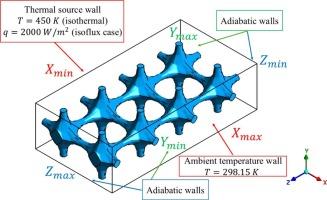嵌入相变材料作为导热增强剂的晶格结构性能的比较研究
IF 2.6
3区 工程技术
Q2 ENGINEERING, MECHANICAL
International Journal of Heat and Fluid Flow
Pub Date : 2025-08-11
DOI:10.1016/j.ijheatfluidflow.2025.110000
引用次数: 0
摘要
相变材料(PCMs)越来越被认为是被动热管理的可行替代方案,由于其特殊的热性能,特别是其高潜热容量,可以作为传统散热器的替代品。然而,它们的低导热率提出了一个重大挑战,特别是在微重力环境中,只有热传导传热。为了缓解这一问题,pcm与多孔材料(如开孔金属泡沫)相结合,起到导热增强剂(tce)的作用。晶格结构已经成为传统开孔金属泡沫材料(如tce)的一种有前途的替代品,它提供了一种有规律组织的周期性结构,有助于改进制造。本研究利用计算流体动力学(CFD)方法研究了四种嵌入pcm的点阵夹层板:简单结构、八元结构、八元结构和v立方结构。所有这些配置是制造相同的总体积和支柱直径。然而,考虑晶格结构的孔隙尺度特征,可以观察到Octa构型的孔隙度值最高,而Simple构型的孔隙度值最低。这导致最高和最低的PCM比率分别为1.07和1。因此,这些差异导致最高和最低的时间稳定比分别为1.35和1。结果表明,简单的结构获得了最高的PCM跃迁率和能量统一比,突出了其显著的能量吸收能力。相反,Octa结构的PCM跃迁率和能量比最低,分别为0.79和0.89。然而,Octa结构的PCM效率最高,为87%,而Simple结构的PCM效率为73%,因为它的PCM比率最高。与纯PCM相比,所有结构都显著提高了有效导热系数。具体来说,八元体的增强效果是纯PCM的27倍,这是由于其表面体积比是其他构型的两倍多。本文章由计算机程序翻译,如有差异,请以英文原文为准。

A comparative study of the performance of lattice structures embedded with phase change materials as thermal conductivity enhancers
Phase Change Materials (PCMs) are increasingly recognized as a viable alternative for passive thermal management, serving as substitutes for traditional heat sinks due to their exceptional thermal properties, particularly their high latent heat capacity. However, their low thermal conductivity presents a significant challenge, specifically in the microgravity environment, where there is only thermal conduction heat transfer. To mitigate this issue, PCMs have been integrated with porous materials, such as open-cell metal foams, which act as Thermal Conductivity Enhancers (TCEs). Lattice structures have emerged as a promising alternative to conventional open-cellular metal foams as TCEs, offering a regularly organized periodic structure that facilitates improved manufacturing. This study investigates four PCM-embedded lattice sandwich panels: Simple, Octa, Octet, and V-cube structures, utilizing the Computational Fluid Dynamics (CFD) method. All these configurations are manufactured with the same total volume and strut diameter. However, considering the pore-scale characteristics of the lattice structures, it is observed that the Octa configuration has the highest porosity value, while the Simple configuration has the lowest. This results in the highest and lowest PCM ratios of 1.07 and unity, respectively. Consequently, these differences lead to the highest and lowest time-to-steady ratios of 1.35 and unity, respectively. The results indicate that the Simple structure achieved the highest PCM transition rate and energy ratio of unity, highlighting its significant capacity for energy absorption. Conversely, the Octa structure exhibited the lowest PCM transition rate and energy ratio of 0.79 and 0.89, respectively. However, the Octa structure demonstrated the highest PCM efficacy of 87%, compared to 73% for the Simple structure, as it has the highest PCM ratio. All structures significantly improve effective thermal conductivity compared to pure PCM. Specifically, the Octet exhibits an enhancement exceeding 27 times that of pure PCM, which is attributable to its surface-to-volume ratio being more than twofold of alternative configurations.
求助全文
通过发布文献求助,成功后即可免费获取论文全文。
去求助
来源期刊

International Journal of Heat and Fluid Flow
工程技术-工程:机械
CiteScore
5.00
自引率
7.70%
发文量
131
审稿时长
33 days
期刊介绍:
The International Journal of Heat and Fluid Flow welcomes high-quality original contributions on experimental, computational, and physical aspects of convective heat transfer and fluid dynamics relevant to engineering or the environment, including multiphase and microscale flows.
Papers reporting the application of these disciplines to design and development, with emphasis on new technological fields, are also welcomed. Some of these new fields include microscale electronic and mechanical systems; medical and biological systems; and thermal and flow control in both the internal and external environment.
 求助内容:
求助内容: 应助结果提醒方式:
应助结果提醒方式:


